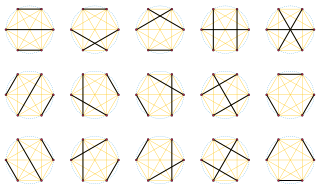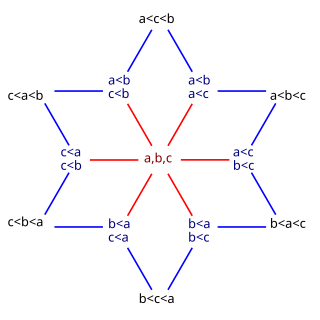In mathematics, the Bernoulli numbersBn are a sequence of rational numbers which occur frequently in analysis. The Bernoulli numbers appear in the Taylor series expansions of the tangent and hyperbolic tangent functions, in Faulhaber's formula for the sum of m-th powers of the first n positive integers, in the Euler–Maclaurin formula, and in expressions for certain values of the Riemann zeta function.

In mathematics, the Fibonacci sequence is a sequence in which each number is the sum of the two preceding ones. Numbers that are part of the Fibonacci sequence are known as Fibonacci numbers, commonly denoted Fn . The sequence commonly starts from 0 and 1, although some authors start the sequence from 1 and 1 or sometimes from 1 and 2. Starting from 0 and 1, the sequence begins
In mathematics, the Euler numbers are a sequence En of integers defined by the Taylor series expansion
In mathematics, a recurrence relation is an equation according to which the th term of a sequence of numbers is equal to some combination of the previous terms. Often, only previous terms of the sequence appear in the equation, for a parameter that is independent of ; this number is called the order of the relation. If the values of the first numbers in the sequence have been given, the rest of the sequence can be calculated by repeatedly applying the equation.
In combinatorial mathematics, the Bell numbers count the possible partitions of a set. These numbers have been studied by mathematicians since the 19th century, and their roots go back to medieval Japan. In an example of Stigler's law of eponymy, they are named after Eric Temple Bell, who wrote about them in the 1930s.

In combinatorial mathematics, the Catalan numbers are a sequence of natural numbers that occur in various counting problems, often involving recursively defined objects. They are named after the French-Belgian mathematician Eugène Charles Catalan.

In number theory, the partition functionp(n) represents the number of possible partitions of a non-negative integer n. For instance, p(4) = 5 because the integer 4 has the five partitions 1 + 1 + 1 + 1, 1 + 1 + 2, 1 + 3, 2 + 2, and 4.
In mathematics, Euler's pentagonal number theorem relates the product and series representations of the Euler function. It states that
In mathematics, the Fibonacci polynomials are a polynomial sequence which can be considered as a generalization of the Fibonacci numbers. The polynomials generated in a similar way from the Lucas numbers are called Lucas polynomials.

In mathematics, the double factorial of a number n, denoted by n‼, is the product of all the positive integers up to n that have the same parity as n. That is,
In mathematics, the nth Motzkin number is the number of different ways of drawing non-intersecting chords between n points on a circle. The Motzkin numbers are named after Theodore Motzkin and have diverse applications in geometry, combinatorics and number theory.

In mathematics, the plastic ratio is a geometrical proportion close to 53/40. Its true value is the real solution of the equation .
In combinatorial mathematics, an alternating permutation of the set {1, 2, 3, ..., n} is a permutation (arrangement) of those numbers so that each entry is alternately greater or less than the preceding entry. For example, the five alternating permutations of {1, 2, 3, 4} are:

In number theory and enumerative combinatorics, the ordered Bell numbers or Fubini numbers count the number of weak orderings on a set of elements. Weak orderings arrange their elements into a sequence allowing ties, such as might arise as the outcome of a horse race). Starting from , these numbers are
In mathematics, the Fibonacci numbers form a sequence defined recursively by:
In mathematics, a Delannoy number describes the number of paths from the southwest corner (0, 0) of a rectangular grid to the northeast corner (m, n), using only single steps north, northeast, or east. The Delannoy numbers are named after French army officer and amateur mathematician Henri Delannoy.
In mathematics, the Dickson polynomials, denoted Dn(x,α), form a polynomial sequence introduced by L. E. Dickson (1897). They were rediscovered by Brewer (1961) in his study of Brewer sums and have at times, although rarely, been referred to as Brewer polynomials.

In mathematics, the telephone numbers or the involution numbers form a sequence of integers that count the ways n people can be connected by person-to-person telephone calls. These numbers also describe the number of matchings of a complete graph on n vertices, the number of permutations on n elements that are involutions, the sum of absolute values of coefficients of the Hermite polynomials, the number of standard Young tableaux with n cells, and the sum of the degrees of the irreducible representations of the symmetric group. Involution numbers were first studied in 1800 by Heinrich August Rothe, who gave a recurrence equation by which they may be calculated, giving the values

In mathematics and theoretical computer science, a constant-recursive sequence is an infinite sequence of numbers in which each number in the sequence is equal to a fixed linear combination of one or more of its immediate predecessors. The concept is variously known as a linear recurrence sequence, linear-recursive sequence, linear-recurrent sequence, a C-finite sequence, or a solution to a linear recurrence with constant coefficients.

In mathematics, the supergolden ratio is a geometrical proportion close to 85/58. Its true value is the real solution of the equation .








































